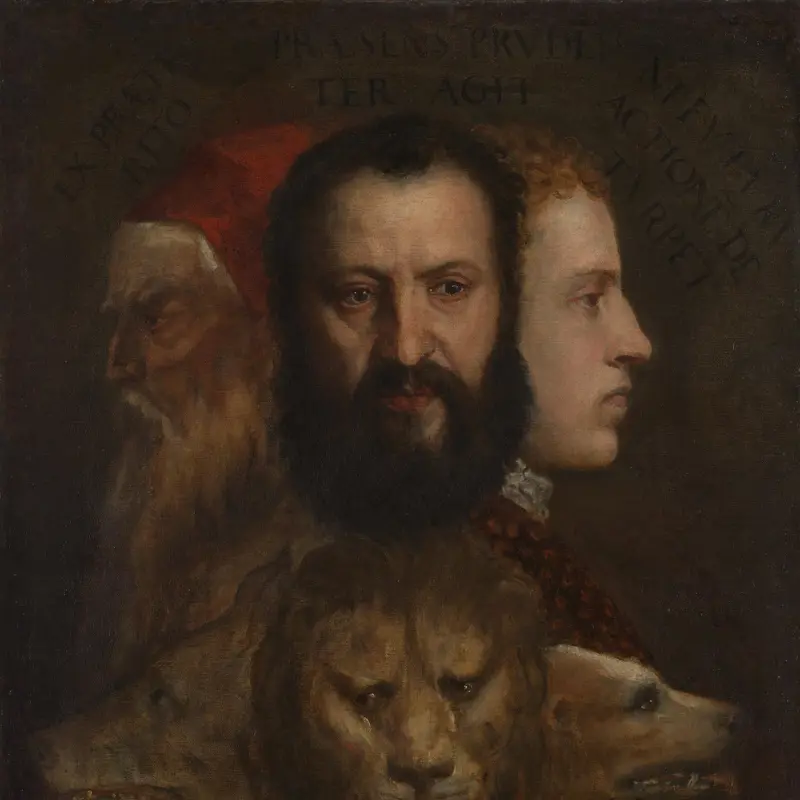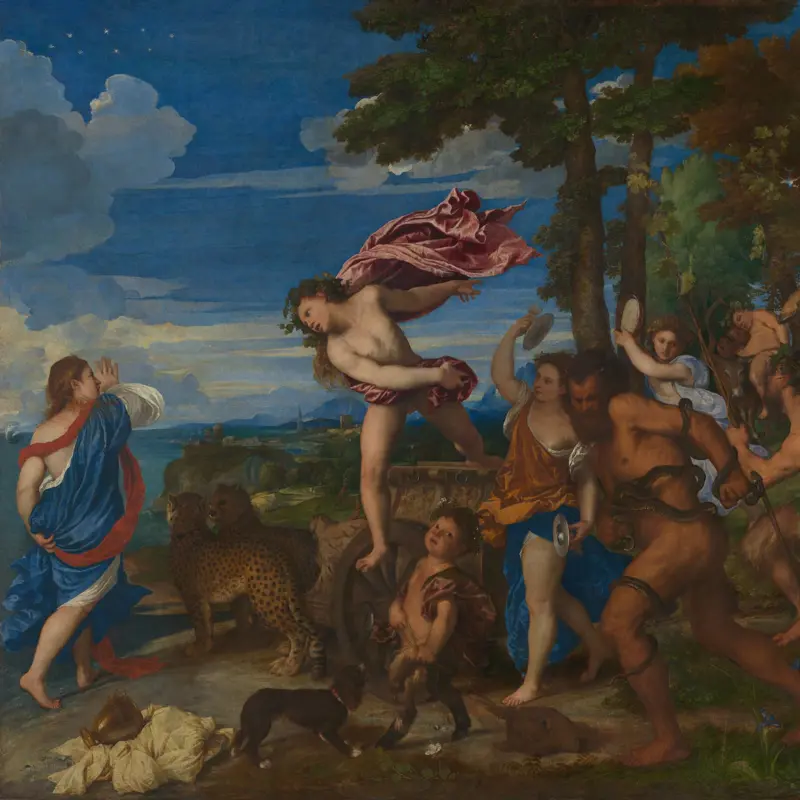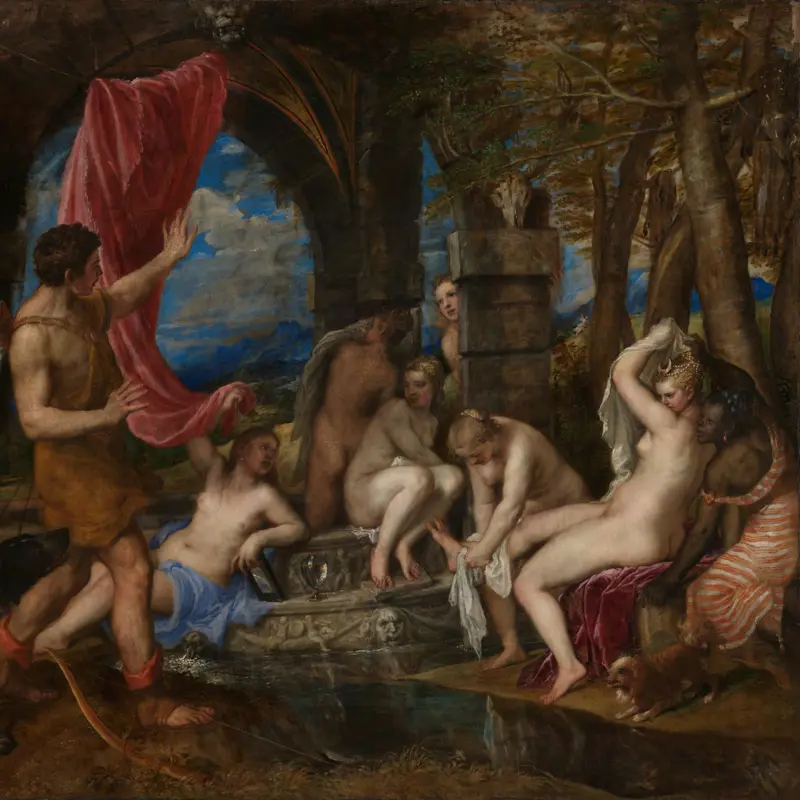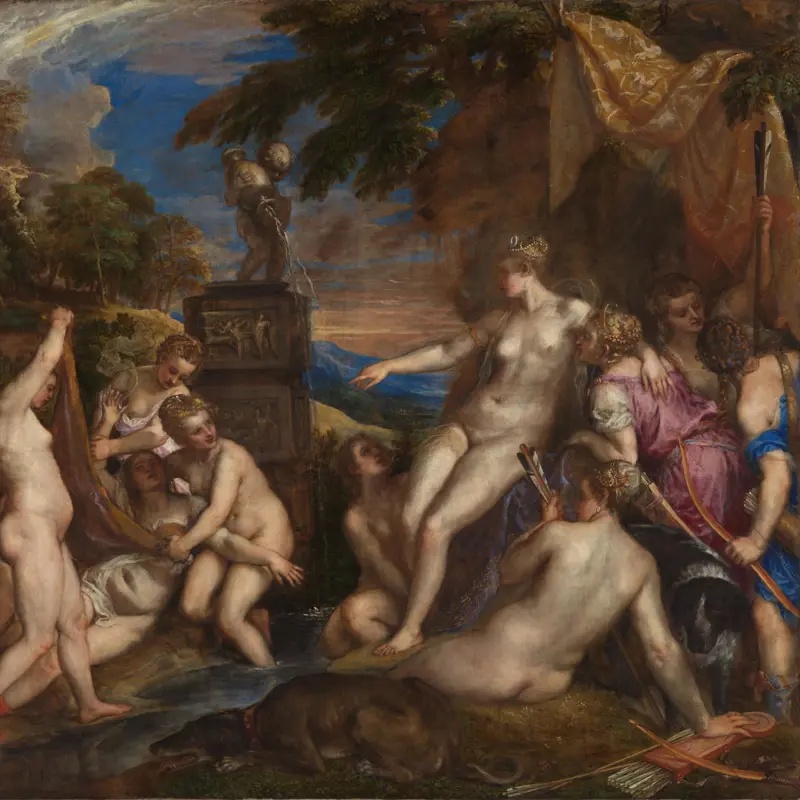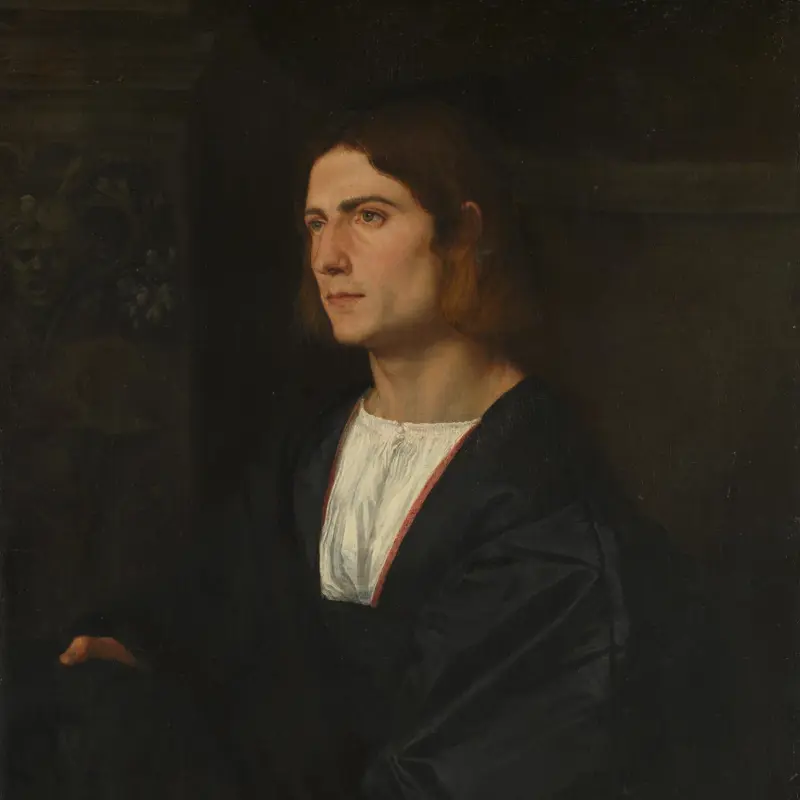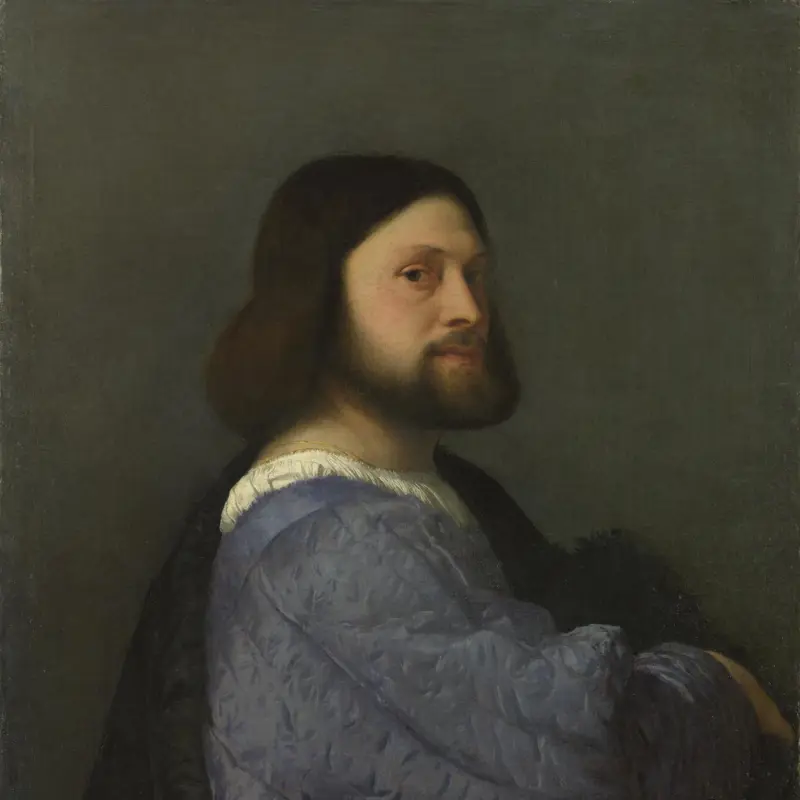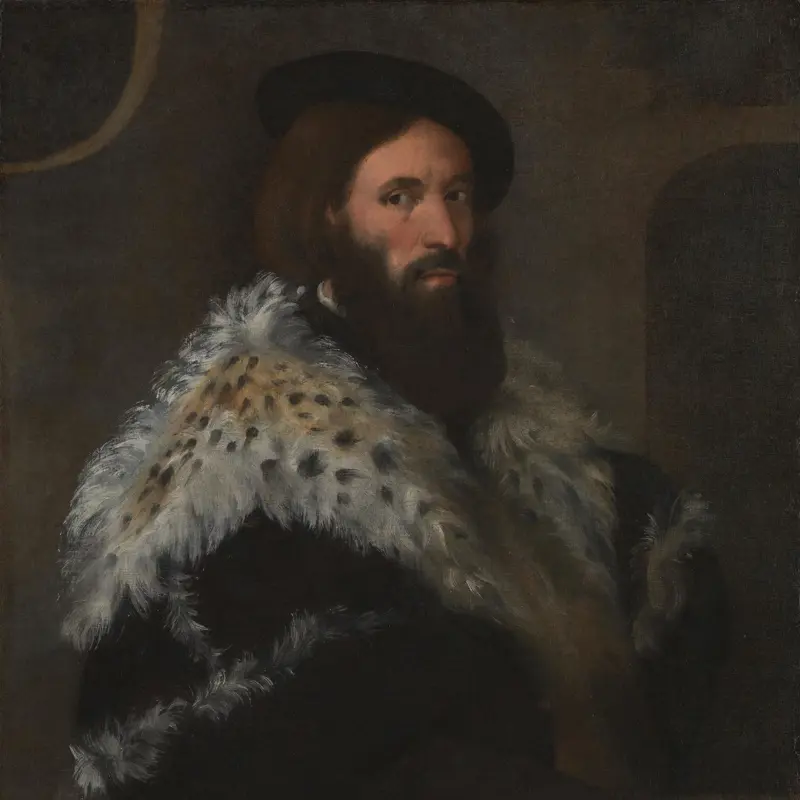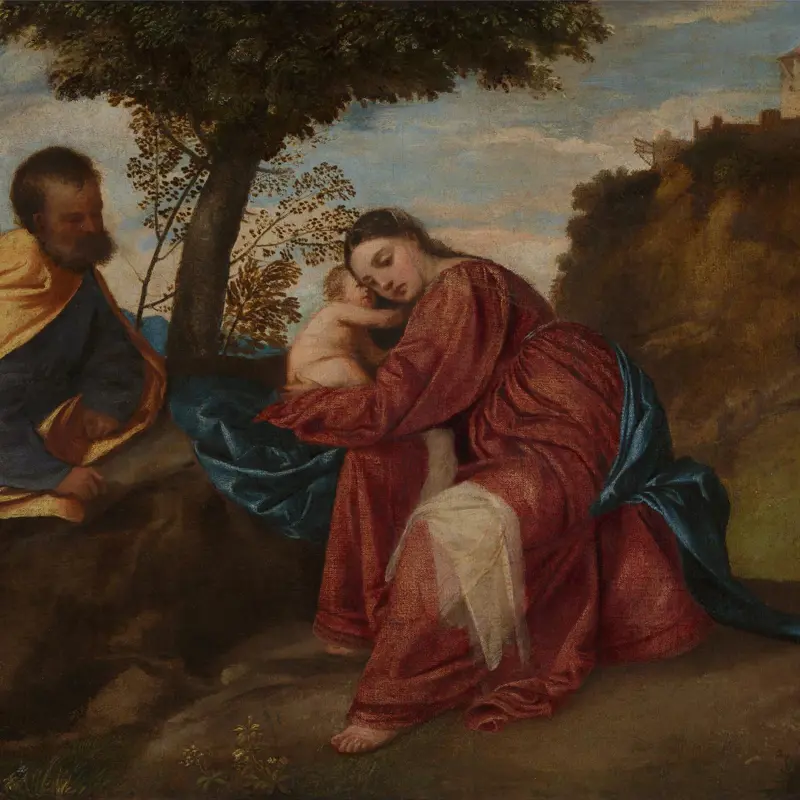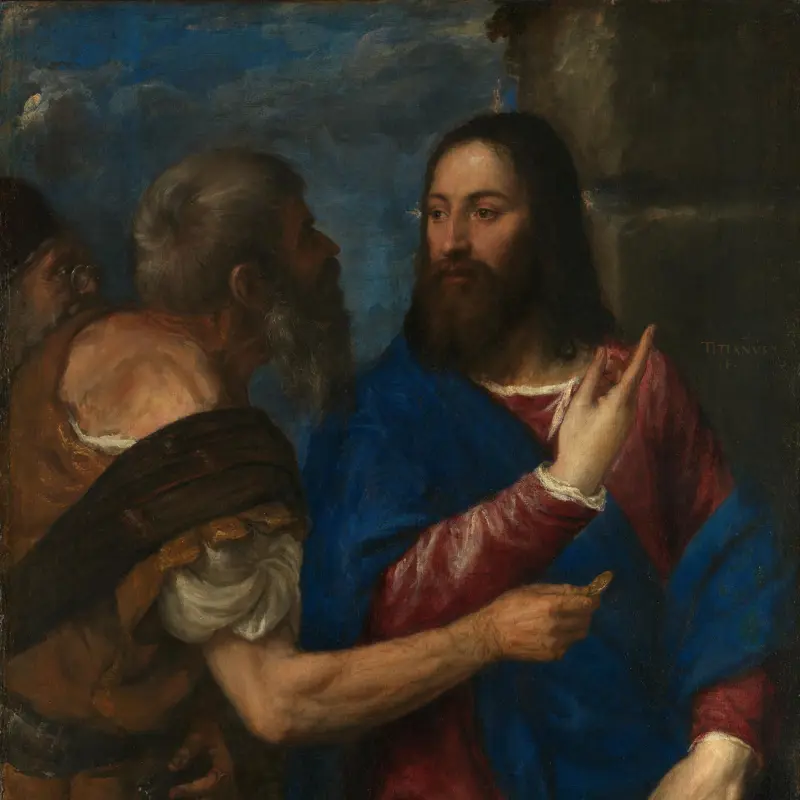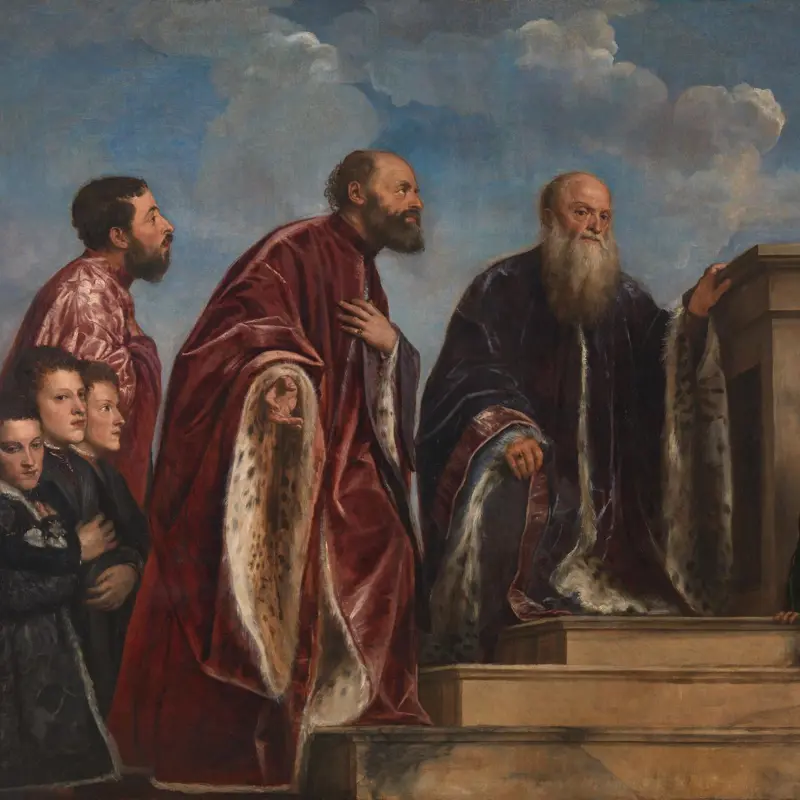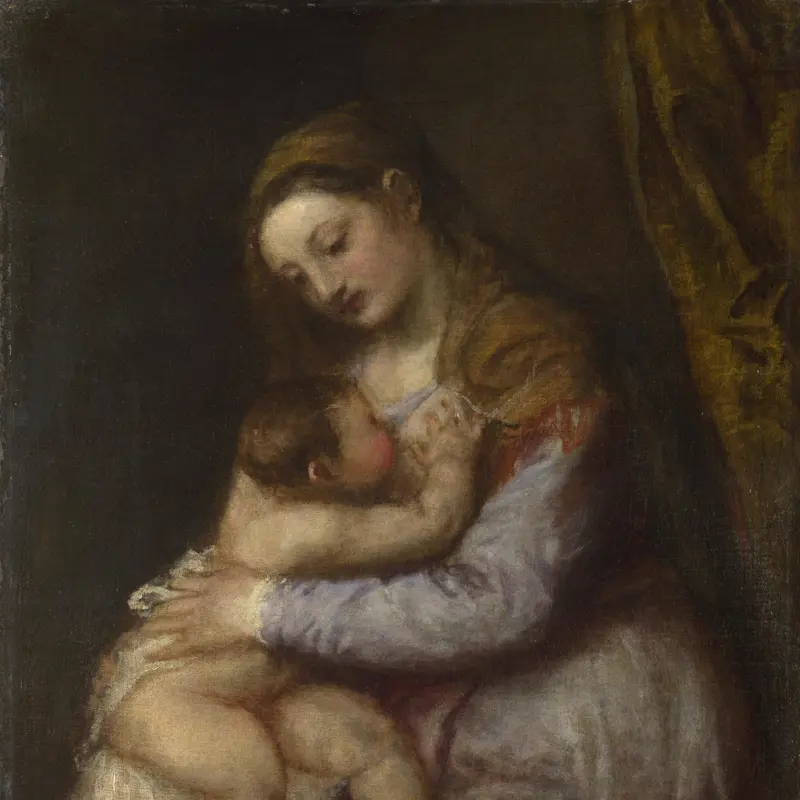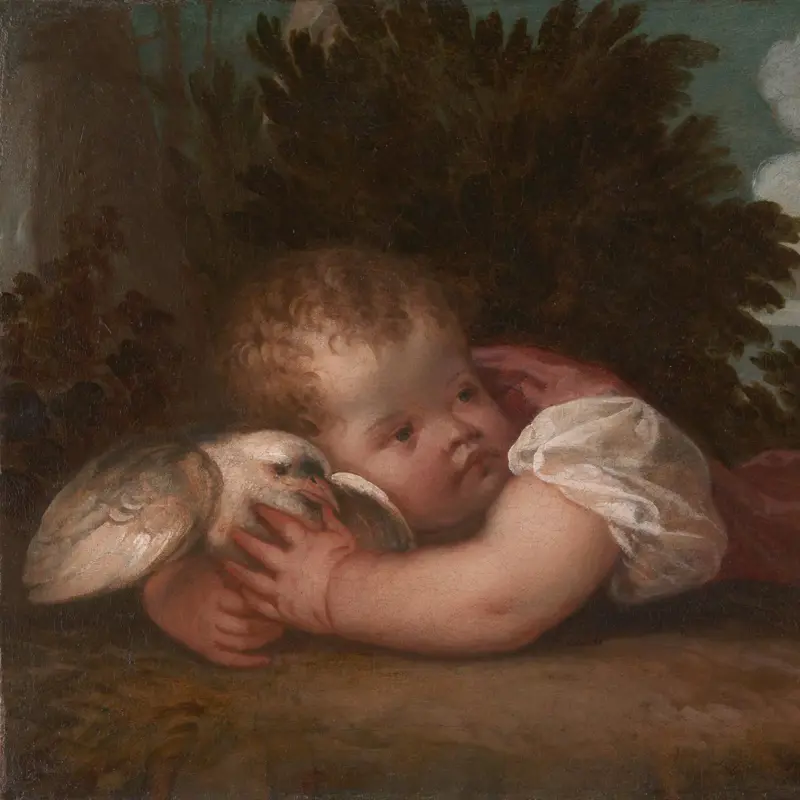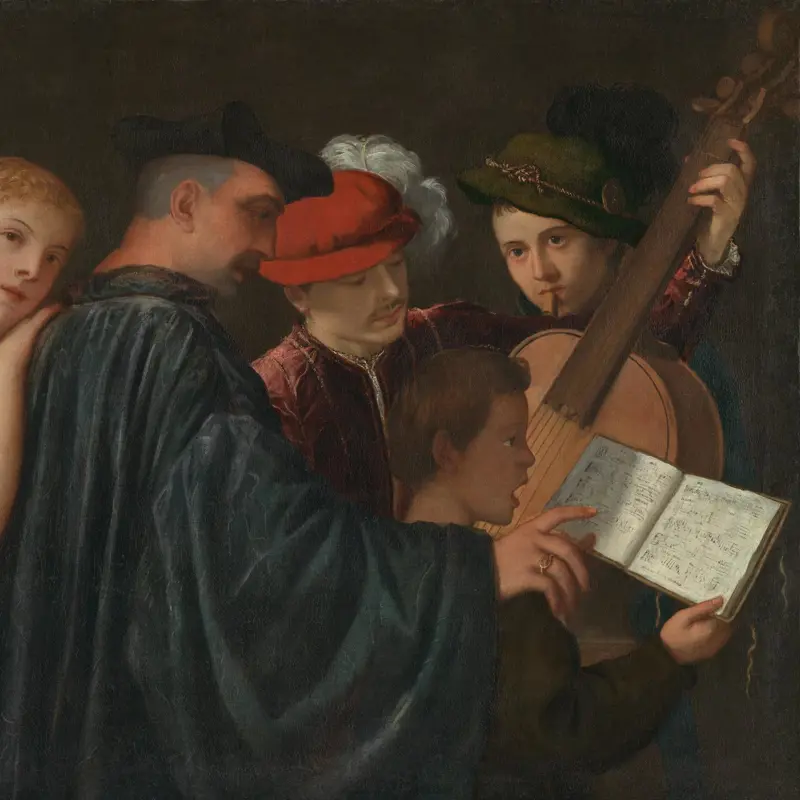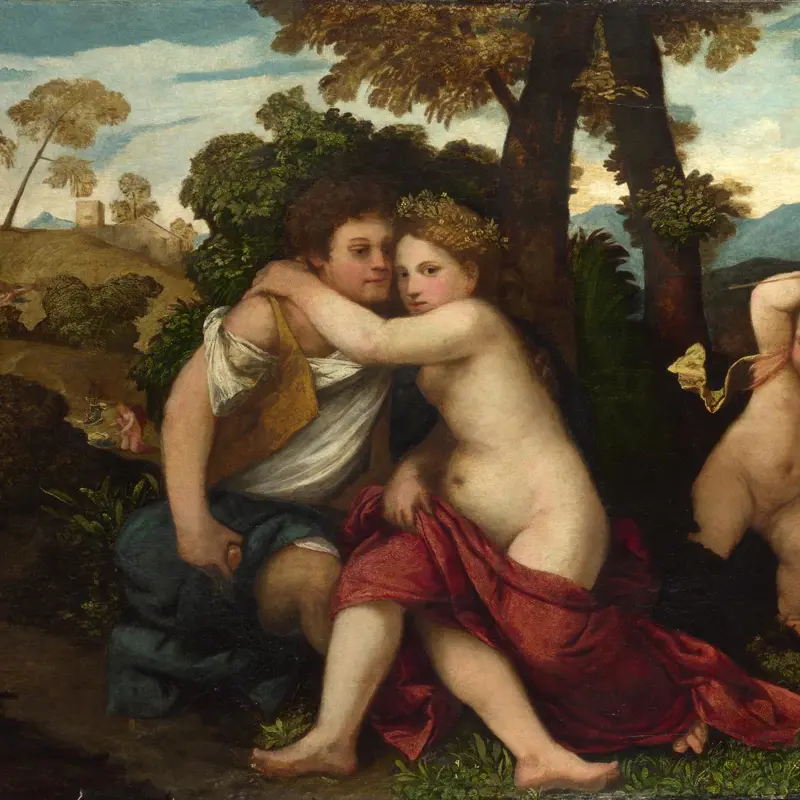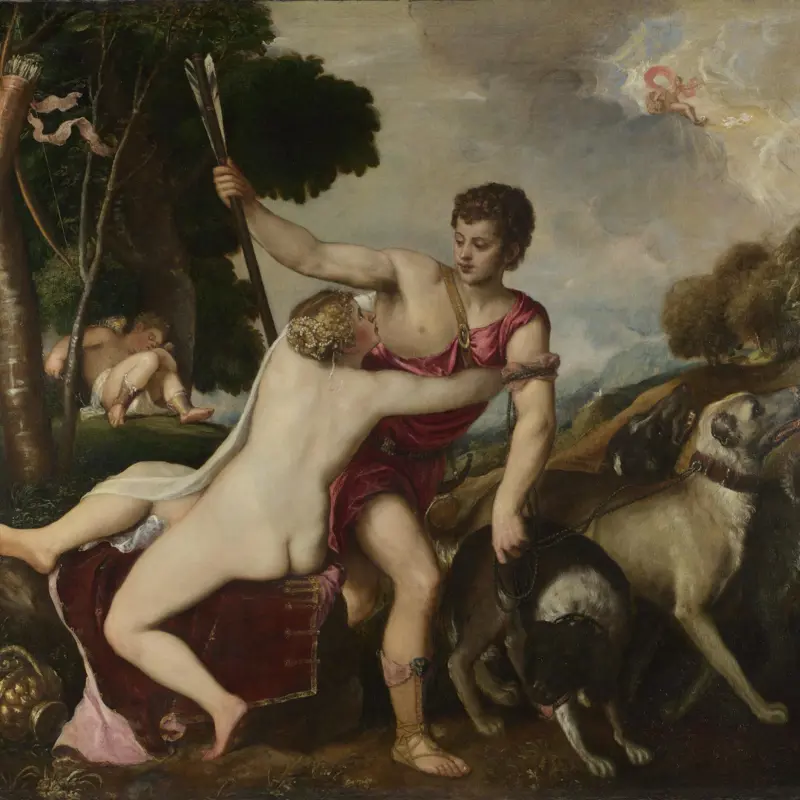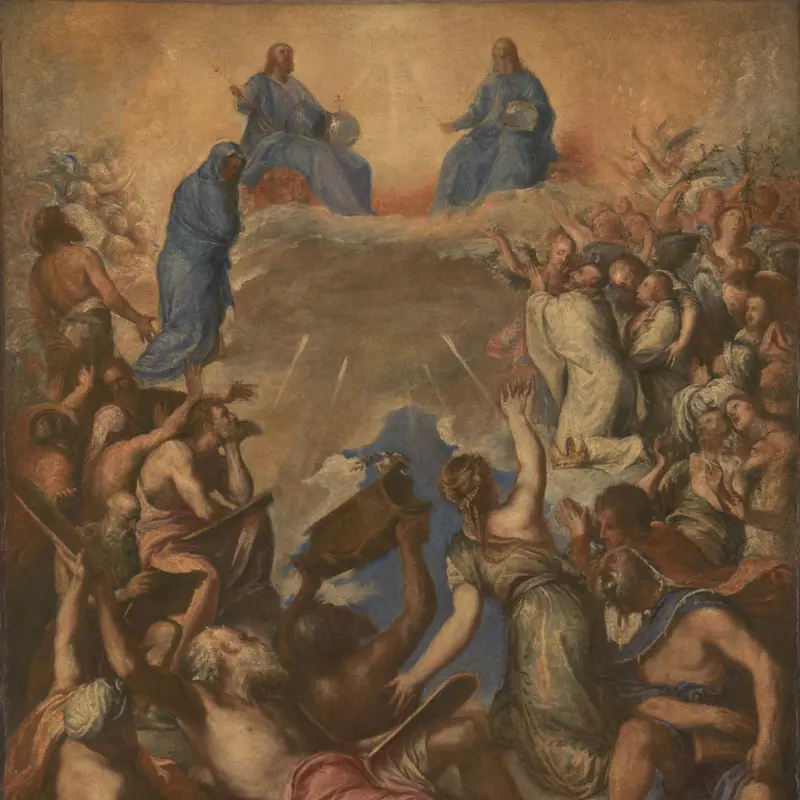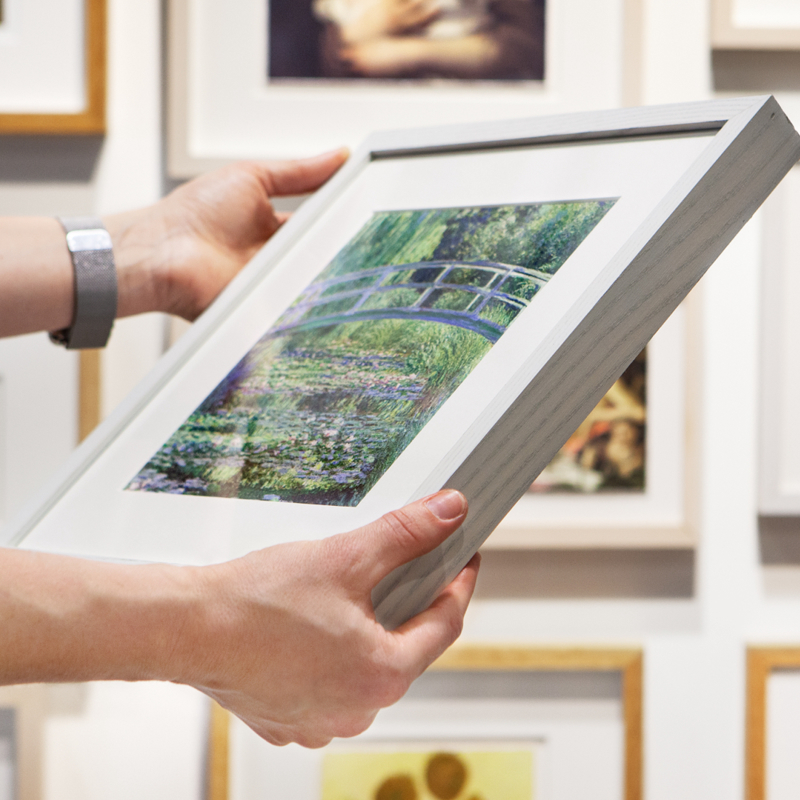Titian, 'Noli me Tangere', about 1514
About the work
Overview
Risen from the dead, Christ appears to his grieving follower, Mary Magdalene, in the Garden of Gethsemane. At first she mistakes him for a gardener but then reaches out her hand in wonder. Christ says, ‘Do not touch me’ (in Latin, noli me tangere); it is time for his followers to let go of his earthly presence and await the Holy Ghost (John 20: 14–18).
This is one of the earliest works by Titian in the National Gallery’s collection. Its high-key colours and the way the figures are set in a natural landscape echo the style of Giorgione, with whom Titian trained. The lines of the tree and the hillside draw attention to the look between the figures. Titian has suggested Christ’s gauzy loincloth and Mary Magdalene’s scarf with dragged brushstrokes of lead white that catch the texture of the painting’s canvas.
Key facts
Details
- Full title
- Noli me Tangere
- Artist
- Titian
- Artist dates
- Active about 1506; died 1576
- Date made
- About 1514
- Medium and support
- Oil on canvas
- Dimensions
- 110.5 × 91.9 cm
- Acquisition credit
- Bequeathed by Samuel Rogers, 1856
- Inventory number
- NG270
- Location
- Room 8
- Collection
- Main Collection
- Frame
- 20th-century Replica Frame
Provenance
Additional information
Text extracted from the ‘Provenance’ section of the catalogue entry in Cecil Gould, ‘National Gallery Catalogues: The Sixteenth Century Italian Schools’, London 1987; for further information, see the full catalogue entry.
Exhibition history
-
2012Titian's First Masterpiece: The Flight Into EgyptThe National Gallery (London)4 April 2012 - 19 August 2012
-
2019Titian and the Renaissance in VeniceStädelsches Kunstinstitut und Städtische Galerie13 February 2019 - 26 May 2019
-
2020Masterpieces from the National Gallery, LondonThe National Museum of Western Art18 June 2020 - 18 October 2020The National Museum of Art3 November 2020 - 31 January 2021
-
2021Botticelli to Van Gogh: Masterpieces from the National Gallery, LondonNational Gallery of Australia5 March 2021 - 14 June 2021
Bibliography
-
1749A.-N. Dézallier d'Argenville, Voyage pittoresque de Paris, ou, Indication de tout ce qu'il y a de plus beau dans cette grande ville, en peinture, sculpture, & architecture, Paris 1749
-
1833J.D. Passavant, Kunstreise durch England und Belgien, Frankfurt am Main 1833
-
1854G.F. Waagen, Treasures of Art in Great Britain: Being and Account of the Chief Collections of Paintings, Drawings, Sculptures, Illuminated Mss. […], vol. 2, trans. E. Eastlake, London 1854
-
1877J.A. Crowe and G.B. Cavalcaselle, Titian: His Life and Times, London 1877
-
1903O. Fischel, Tizian: Des Meisters Gemälde, Berlin 1903
-
1906H.F. Cook, 'Notes on the Study of Titian', The Burlington Magazine, X/44, 1906, pp. 102-8
-
1934G.M. Richter, 'Unfinished Pictures by Giorgione', Art Bulletin, XVI/3, 1934, pp. 272-90
-
1934G.M. Richter, 'The Problem of the "Noli me Tangere"', The Burlington Magazine, LXV/376, 1934, pp. 4-16
-
1958C. Gould, 'A Famous Titian Restored', The Burlington Magazine, C/659, 1958, pp. 44-50
-
1959Gould, Cecil, National Gallery Catalogues: The Sixteenth Century Venetian School, London 1959
-
1969H.E. Wethey, The Paintings of Titian: The Religious Paintings, 3 vols, London 1969
-
1975C. Gould, Delaroche and Gautier: Gautier's Views on the 'Execution of Lady Jane Grey' and on other Compositions by Delaroche, London 1975
-
1978R. Pallucchini, Tiziano e il Manierismo europeo, Florence 1978
-
1980C. Hope, Titian, London 1980
-
1984D. Sutton, 'Aspects of British Collecting, III.XIII: The Orléans Collection', Apollo, CXIX/267, 1984, pp. 357-72
-
1985J. Dundas, 'A Titian Enigma', Artibus et historiae, VI/12, 1985, pp. 39-55
-
1987Gould, Cecil, National Gallery Catalogues: The Sixteenth Century Italian Schools, London 1987
-
1988S.M. Newton, The Dress of the Venetians, 1495-1525, Aldershot 1988
-
1992P.P. Fehl, Decorum and Wit: The Poetry of Venetian Painting: Essays in the History of the Classical Tradition, Vienna 1992
-
1993A. Steinberg, 'Blurred Boundaries, Opulent Nature, and Sensuous Flesh: Changing Technological Styles in Venetian Painting, 1480-1520', Studies in the History of Art, XLV, 1993, pp. 198-220
-
1993M. Laclotte (ed.), Le siècle de Titien: L'âge d'or de la peinture à Venise (exh. cat. Galeries Nationales du Grand Palais, 9 March - 14 June 1993), Paris 1993
-
1994A. Schnapper, Curieux du Grand Siècle: Collections et collectionneurs dans la France du XVIIe siècl, Paris 1994
-
1995E. Guidoni, Studi su Giorgione e sulla pittura del suo tempo: Conferenze 1995-96, 5 vols, Rome 1995
-
1995M.G. Bernardini, Tiziano: Amor sacro e amor profano (exh. cat. Palazzo delle Esposizioni (Rome), 22 March - 22 May 1995), Rome 1995
-
1997R. Goffen, Titian's Women, New Haven 1997
-
1999J. Drury, Painting the Word: Christian Pictures and Their Meanings, New Haven 1999
-
2000G. Finaldi, The Image of Christ, London 2000
-
2000J. Ruskin, Modern Painters, ed. D. Barrie, revised edn, London 2000
-
2000O. Garnett, 'The Letters and Collection of William Graham: Pre-Raphaelite Patron and Pre-Raphael Collector', The Walpole Society, LXII, 2000, pp. 145-343
-
2001
C. Baker and T. Henry, The National Gallery: Complete Illustrated Catalogue, London 2001
-
2001E. Gass, Der auferstandene Christus: Bilder zur Auferstehung Jesu, zur Himmelfahrt und zu Pfingste, Tübingen 2001
-
2001P. Joannides, Titian to 1518: The Assumption of Genius, New Haven 2001
-
2001F. Pedrocco, Titian: The Complete Paintings, London 2001
-
2002D. Bomford et al., Underdrawings in Renaissance Paintings (exh. cat. The National Gallery, 30 October 2002 - 16 February 2003), London 2002
-
2003D. Jaffé (ed.), Titian, London 2003
-
2003J. Dunkerton and M. Spring, 'The Technique and Materials of Titian's Early Paintings in the National Gallery, London', Restoration, III/1, 2003, pp. 9-22
-
2003C. Hope et al., Titian (exh. cat. The National Gallery, 19 February - 18 May 2003; Museo Nacional del Prado, 10 June - 7 September 2003), London 2003
-
2005D.A. Brown, 'Titian and Bellini: From Pupil to Rival', Arte Cristiana, XCIII/831, 2005, pp. 425-42
-
2006L. Fuccia, 'Pour "la satisfaction tant attendue " et "les desirs passionnes" du marquis de Seignelay. Une correspondance inedite sur le voyage d'Alvarez en Italie', Revue de l'art, 152, 2006, pp. 37-52
-
2006D.A. Brown et al., Bellini, Giorgione, Titian and the Renaissance of Venetian Painting (exh. cat. National Gallery of Art, Washington, 18 June - 17 September 2006; Kunsthistorisches Museum, 17 October 2006 - 7 January 2007), New Haven 2006
-
2007W. Eller, Giorgione: Catalogue Raisonné: Mystery Unveiled, Petersberg 2007
-
2007B. Baert, '"Noli me Tangere" or the Untouchable Body. Five Exercises in the Prohibition of Touching', Jaarboek van het Koninklijk Museum voor Schone Kunsten, Antwerpen, 2007, pp. 8-21
-
2008L.M. Rafanelli, 'Sense and Sensibilities: A Feminist Reading of Titian's "Noli me Tangere"', Critica d'arte, LXX/8, 2008, pp. 28-47
About this record
If you know more about this work or have spotted an error, please contact us. Please note that exhibition histories are listed from 2009 onwards. Bibliographies may not be complete; more comprehensive information is available in the National Gallery Library.

